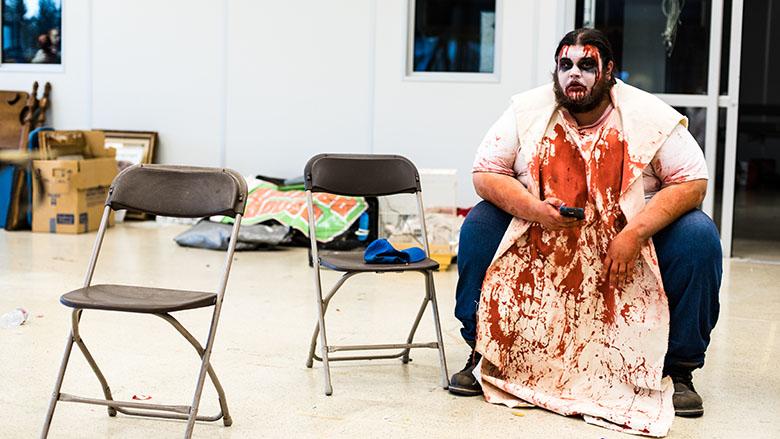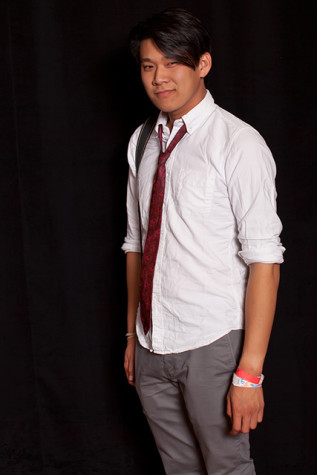Darkness surrounds the room. The sound of heavy footsteps slowly approach. Your heart beats faster and faster. Chills go down your spine. You can feel it, but you can’t see it.
Typically, people tend to avoid these types of situations. But it’s October, the month of goblins, vampires and ghastly creatures, when we stop running from the monsters, and instead dress up like them. When we wait in lines and pay to be scared. When we indulge in our fears for fun.
One of the North Bay’s biggest Halloween attractions, Blind Scream, provides three haunted houses venturing into the world of our common fears; from walking through a pitch-black maze filled with monsters lurking in the dark to blood-covered, deranged clowns flashing sinister smiles.
Co-owners Drew Dominguez and Judy Groverman Walker discuss the process of creating haunted houses sure to make you cringe, if not scream.
The Actors
Since the haunted house’s relocation to Sonoma Mountain Village in Rohnert Park, Blind Scream has closely worked with Rancho Cotate High School, with many of their students joining the acting crew.
Blind Scream also reaches out to other parts of the community, with their actors all being volunteers. Monique Cortes, 14, joined the crew four years ago when Blind Scream asked the Boys and Girls Club to participate.
“I decided a year later that I wanted to come back,” Cortes said. “I was like ‘I want to be an actor.’”
With more than 120 actors this year and open for 17 nights, different actors play different roles each night.
“It’s kind of a challenge,” Walker said. “Kind of a little puzzle to piece everybody into place and make sure we got all of our positions covered with actors that fit that part.”
Walker and Dominguez figure out who fits best for a role by holding auditions.
“Some people are very shy,” Walker said. “We realize either they can be taught or maybe we need to find them a role that better fits their ability.”
Actors who struggle or “freeze up” during their performance receive training to help them overcome stage fright.
“We put them in the house, we walk through, we give them opportunity to scare,” Walker said.
Aside from being able to perform on spot, actors must have the ability to improvise as people pass through. Groups are specifically asked to go in pairs in order for actors to fully fright their guests in such limited time and space.
“It’s a different kind of acting,” Walker said. “They have to keep doing it every 30 seconds as somebody keeps coming through. They got to have that stamina to keep those lines and they have to be kind of quick thinking with their lines.”
Although they can’t have too many actors in each haunted house, they try to let everybody join in the fun.
“We don’t really turn actors away,” Walker said.
Disturbing Design
Besides the demented characters the actors play, what other elements makes Blind Scream’s haunted houses so horrifying?
Walker believes it’s how realistic they are. From their hand-me-down props to their no use of animatronics.
“[Dominguez] makes a lot of the props, but most of our stuff is not props you buy from a Halloween store. It’s stuff that we buy from Goodwill, or we find and reuse,” Walker said. “It needs to look old and kind of broken.”
Before props are assembled and displayed, a team of volunteers come two months prior to build the haunted house.
“We get all the walls, we get the paint up, then we start decorating the last two weeks,” Walker said. “You can see it’s a warehouse, but once you get in there, it’s different.”
Once decorated and lighted, they set up sounds and smells.
“We have different smells that we put in the house. We’ve got one that is dead chicken, rotten leaves, fried carcass. They’re nasty,” Walker said. “It’s just part of the haunted house industry. They sell all these smells.”
Safety then Scare
The facade of scary scenarios can compromise safety, but safety of the actors and the guests are first and foremost at Blind Scream.
Not only does the fire department highly regulate Blind Scream, but it’s one of the reasons they have “chicken doors” throughout the haunted houses in case people get too scared or need to evacuate.
“We have no plastic. A lot of haunted houses use black plastic. That’s highly flammable,” Walker said. “We really have to be careful what we use and how we use things and make sure that it’s safe, and we train our actors to make sure they’re safe with the public. Safety is a really big thing.”
The Scream Routine
Before the fake blood and sharp fangs come out, the acting crew has dinner to nourish them before a long night of scaring and screaming.
At 5:30 p.m., actors begin applying makeup and dress in their gory gear.
Farther in the corner, away from the costume chaos, makeup artist Adela Mora, 29, puts makeup on 72-year-old Ray Hernandez, who plays grandpa in a frightening family.
Hernandez is the oldest member in the acting crew with a group of 10-year-old girls as the youngest.
“It’s nice to have that age range cause a lot of times we’re putting a mask on someone to make them look old or young,” Walker said.
After the actors dress and opening time draws near, they assume their positions.
Seven o’clock hits. The lights go out. Ready, set, scream.





